810nm Brain Photobiomodulation Helmet
$2,099.00 USD
The 810nm photobiological brain modulation helmet uses non-invasive near-infrared light technology to reshape brain health management. Requiring no surgery or injections, the 810nm light waves penetrate the scalp and skull directly to the brain tissue, making it highly safe and suitable for all individuals. It offers flexible power levels: high power is suitable for severe conditions such as traumatic encephalopathy and Alzheimer’s disease, while low power alleviates dizziness, headaches, and depression. It activates mitochondria in nerve cells, promoting ATP production and neurotransmitter balance, activating anti-apoptotic pathways, and stimulating angiogenesis to improve brain circulation, supporting neural repair and vascular health. The lightweight helmet design conforms to the head shape and is portable and easy to carry, allowing it to be used at home, at work, or while traveling, without the need for specialized medical attention or disruption to daily routines. Compared to medication, it offers minimal side effects and avoids problems such as drowsiness and liver and kidney damage, providing a convenient and safe new option for brain health.
Description
| Model | GY-PDT1 |
| Weight | 2.5 kg |
| Dimensions | 11.26 x 6.30 inches |
| Number of LEDs | 256 |
| Ible>nput voltage | 100-240 V |
| Input current | 800 mAh |
| Wavelength | 810 nm |
| Power | 50 mW |
| Optical power | 24 mW/cm² |
| Frequency | 50-60 Hz |
| Product quality certification | CE、PDA |
Product Lists
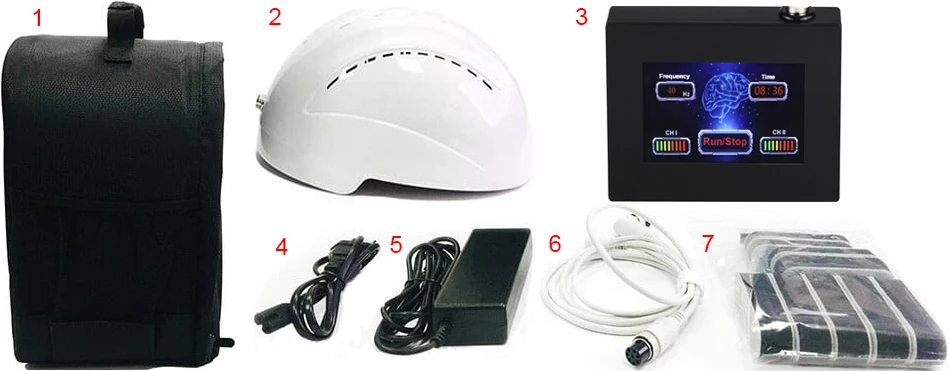
1.Handbag 2.Helmet 3.Touch screen controller 4.power cable 5.Stabilizer 6.Control line 7.Sponge pad
What is photobiomodulation?
Photobiomodulation (PBM) refers to the use of red or near-infrared light to stimulate, heal, regenerate, and protect injured, degenerated, or dying tissue. The brain is susceptible to a variety of different conditions, which can be divided into three major categories: traumatic events (stroke, traumatic brain injury, and global ischemia), degenerative diseases (dementia, Alzheimer’s disease, and Parkinson’s disease), and psychiatric disorders (depression, anxiety, and post-traumatic stress disorder). There is evidence that all of these seemingly unrelated conditions can be beneficially affected by shining light into the head. PBM can even be used to enhance cognition in healthy individuals. In this application of transcranial PBM (tPBM), near-infrared (NIR) light is typically applied to the forehead because it has better penetration (no hair, longer wavelength).
Working Principle
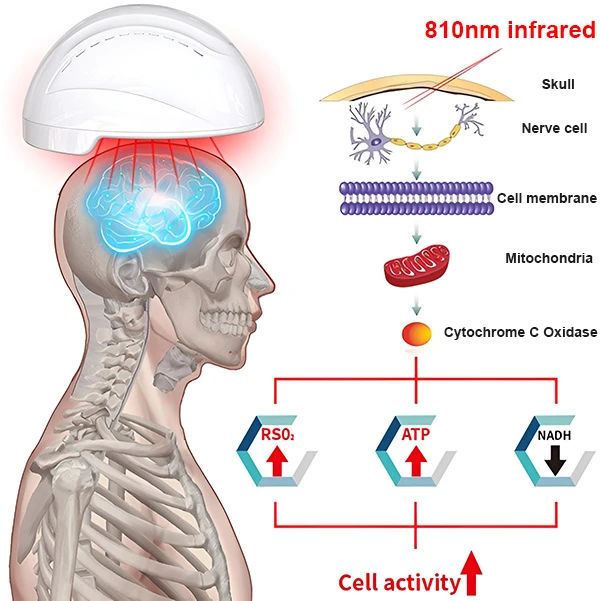
Red/near-infrared light can stimulate complex IV (cytochrome c oxidase) of the mitochondrial respiratory chain and increase ATP (adenosine triphosphate) synthesis. Furthermore, absorption of light energy by ion channels leads to the release of Ca2+, activating transcription factors and gene expression. Infrared light can enhance neuronal metabolic capacity and stimulate anti-inflammatory, anti-apoptotic, and antioxidant responses, as well as neurogenesis and synaptogenesis.
Product Features

Intelligent Frequency Adjustment
Recommended for High Frequency Use of Diseases
| Major disease categories | Specific Disease | Recommended Frequency |
| 1.Cerebrovascular diseases | Cerebral arteriosclerosis, cerebral ischemia | 50 Hz |
| Cerebral thrombosis, cerebral infarction | 50 Hz | |
| Lacunar cerebral infarction | 50 Hz | |
| 2.Neurodegenerative diseases | Cerebral atrophy,Alzheimer’s disease (AD) | 40-50 Hz |
| Parkinson’s disease | 30-50 Hz | |
| 3.Brain injury and recovery period | Postoperative recovery period after brain trauma | 30 Hz |
| Cerebral intoxication recovery period | 30-50 Hz | |
| 4.Psychiatric disorders | Depression | 50 Hz |
| Mental disorders | 30-50 Hz | |
| 5.Somatic and functional symptom-related diseases | Neural headaches | 20-40 Hz |
| Brain fatigue,Memory loss | 30 Hertz |
These diseases are often accompanied by abnormal brain hemodynamics, disordered neuronal activity rhythms, or poor metabolic function. High-frequency (30 Hz and above) 810nm photobiomodulation is more suitable for matching the neural electrical activity characteristics and energy requirements of these pathological conditions. By enhancing the penetration depth and intensity of light energy, it can effectively improve cerebral blood supply, promote neuronal metabolism, and regulate abnormal neural rhythms, thereby alleviating ischemic symptoms, delaying neurodegeneration, accelerating brain damage repair, and improving mood and physical function. At the same time, high-frequency modulation can more accurately activate the functional networks of relevant brain areas, improving intervention efficiency.
Recommended for Low Frequency Use of Diseases
| Major disease categories | Specific diseases | Recommended frequency |
| 1.Neurodevelopmental and Childhood Disorders | Children with Autism | 10-30 Hz |
| Children with Cerebral Palsy | 5-15 Hz | |
| 2.Psychiatric Disorders | Neurasthenia | 5-20 Hz |
| Schizophrenia | 5-20 Hz | |
| 3.Sleep and Somatic Symptom Disorders | Insomnia | 5-15 Hz |
| Hypertension | 5-15 Hz |
These diseases are often associated with immature neurodevelopment, imbalanced neural excitability, or autonomic nervous system disorders. Low-frequency modulation is more suited to the sensitive state and rhythmic characteristics of their nervous systems: for children with autism and cerebral palsy, gentle stimulation can regulate abnormal neural connections in the brain, improving social interaction, language skills, and motor coordination. For neurasthenia and schizophrenia, it can soothe overactive neural discharges, relieve anxiety and tension, and stabilize emotions and thinking. For insomnia and hypertension, it can regulate autonomic nervous rhythms, inhibit excessive brain excitation to improve sleep quality, and assist in balancing sympathetic nervous system activity and helping stabilize blood pressure. Overall, by adapting to low-frequency gentle photobiomodulation, targeted improvements in neurodevelopment, mental state, and physical function are achieved, overstimulation of sensitive nervous systems is reduced, and the safety and adaptability of modulation are improved.

Protect Vascular Health
Irradiation with 810nm light can modulate calcium ion concentrations and related signaling pathways within vascular smooth muscle cells, restoring normal contraction and relaxation of smooth muscle cells. In cases of cerebral vascular damage or chronic ischemia, photobiomodulation can also stimulate the expression and secretion of related growth factors, such as vascular endothelial growth factor (VEGF). These growth factors promote endothelial cell proliferation, migration, and differentiation, inducing new angiogenesis and establishing new collateral circulation. This plays a crucial role in improving blood supply to ischemic areas of the brain, as well as in vascular repair and neurological recovery after cerebral infarction.

Neuroprotection and Repair
The emitted near-infrared light can penetrate the scalp and skull, and be absorbed by the cytochrome c oxidase in the mitochondria of nerve cells, thereby enhancing mitochondrial respiration, promoting ATP production, and supplying energy to nerve cells. At the same time, it regulates neurotransmitter levels, promotes the synthesis and release of serotonin and dopamine, and maintains the balance of excitation and inhibition in the brain. It can also activate anti-apoptotic pathways such as PI3K/Akt to inhibit apoptosis of nerve cells. It stimulates nerve and glial cells to secrete nerve growth factor, which helps the growth of nerve cell axons and dendrites and the reconstruction of synaptic connections. It also inhibits the excessive activation of microglia, reduces the release of inflammatory factors, and alleviates neuroinflammation. From the dimensions of energy supply, transmitter regulation, anti-apoptosis, repair promotion, and anti-inflammatory, it protects the health of nerve cells and promotes the recovery of damaged nerve function.
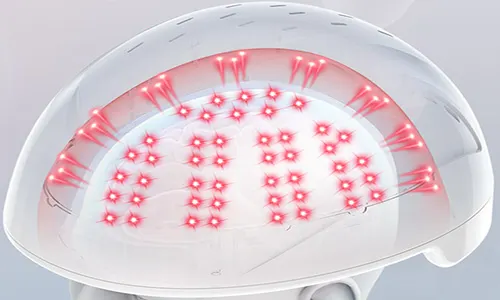
Promotes Enzymatic Reactions
Red and near-infrared light photons penetrate the skull and enter brain cells, stimulating their mitochondria to produce more ATP, thereby promoting neuronal metabolism. Activating cytochrome C oxidase on the mitochondrial membrane accelerates cellular energy production, increases blood flow, and stimulates the secretion of various neuroprotective proteins and growth factors.
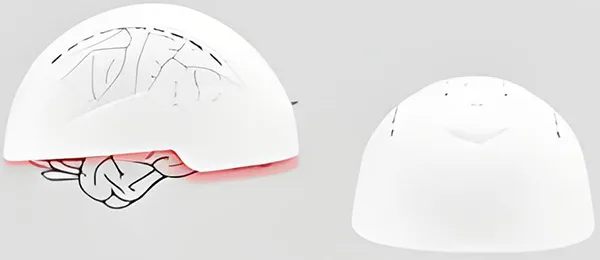
Non-invasive Treatment
There is no need for invasive procedures such as surgery or injections. The near-infrared light emitted by the helmet penetrates the scalp and skull and directly acts on the brain tissue, reducing the risks of infection and bleeding. It is relatively safe and suitable for all types of people, especially those who are concerned about invasive treatments.

Easy to Carry
Designed as a helmet that conforms to the contours of the head, the product easily adapts to various head shapes. Its lightweight materials and scientific ergonomic structure ensure easy portability, allowing users to use it at home, at work, or while traveling, tailored to their needs. Users no longer need to set aside significant time to travel to a specific medical facility; treatment can be completed while navigating daily activities, truly enabling health management without disrupting their normal daily routines.
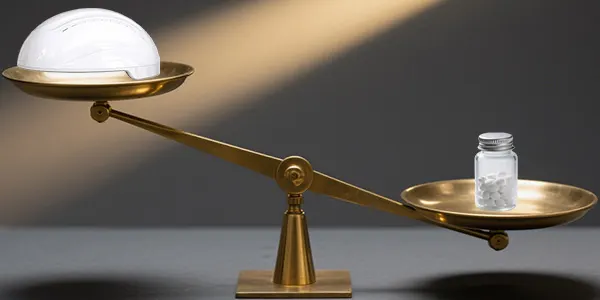
Minimal Side Effects
As a physical intervention, the 810nm photobiomodulation helmet has significantly fewer side effects than drug treatments. It targets mitochondria with a specific wavelength of near-infrared light, modulating cellular metabolism without requiring metabolism in organs like the liver and kidneys. Unlike drugs, it also doesn’t disrupt the systemic endocrine or immune system, resulting in minimal systemic adverse reactions. Furthermore, it eliminates the risks of gastrointestinal irritation, liver and kidney damage, and allergic reactions commonly associated with drug treatments, resulting in a higher overall safety profile and far fewer adverse effects on the human body.
Product Details
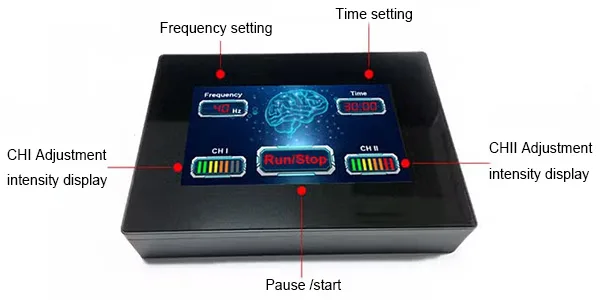
Smart Touch Screen
Screen personalization settings, users can directly set the required time, frequency, etc. The time is adjustable from 1 to 30 minutes, 1 to 20000Hz can be adjusted as needed, and the power levels are 25%-50%-75%-100%.
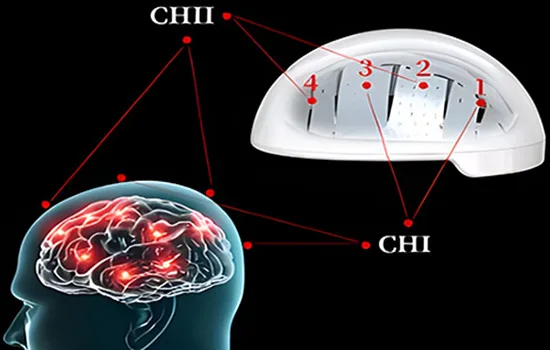
4-quadrant Control
The brain photobiomodulator can control the switch and power supply of CHI/CHII separately, and can treat different areas to achieve the best treatment effect. CHI corresponds to adjusting 1/3 intensity and CHI corresponds to adjusting 2/4 intensity.
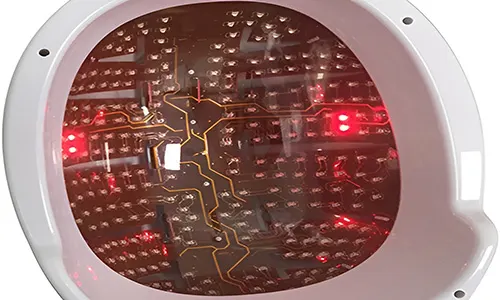
High-power LED Lights
The helmet is equipped with 256 high-power 810nm LEDs, providing uniform light distribution without any blind spots. Each LED is equipped with a convex lens to enhance light concentration, allowing it to penetrate deeper into brain tissue, effectively delivering photobiomodulation (PBM).

ABS Material
Excellent overall performance. It features balanced mechanical properties, impact resistance, and optimal rigidity and hardness; easy processing and molding, excellent colorability; chemical stability, insulation, and moderate density; and top-mounted heat dissipation vents to address heat dissipation issues within the helmet.
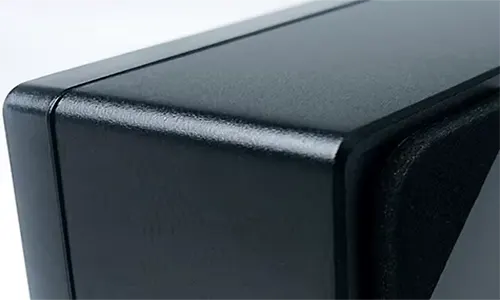
Sandblasted Aluminum Alloy Frame
The aluminum alloy of the sandblasted aluminum alloy frame has good strength, and the sandblasting process greatly improves its wear resistance and damage resistance, which can make the physical structure of the equipment stable in the long term; secondly, the excellent thermal conductivity of aluminum alloy allows for fast heat dissipation inside the equipment, maintaining a suitable operating temperature for electronic components and reducing failures; and sandblasting has a unique matte texture, combining technological beauty and sophistication, and can also enhance corrosion resistance through aluminum alloy and surface structure, adapting to a variety of environments, achieving a comprehensive consideration of performance, appearance and durability.
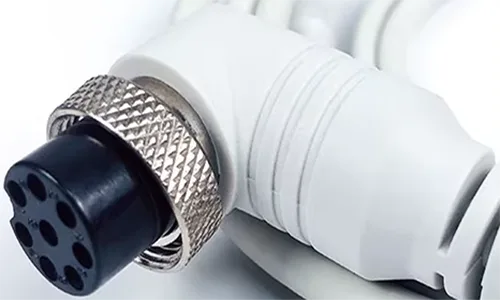
PVC Connecting Wire
It has excellent insulation properties, can effectively isolate current and ensure electrical safety; at the same time, it is wear-resistant and bend-resistant, and is not easily damaged even with frequent movement and bending in daily use, and has a long service life; in addition, PVC material also has good corrosion resistance, can resist the erosion of general acids, alkalis, oils and other substances, and can adapt to a variety of usage environments.
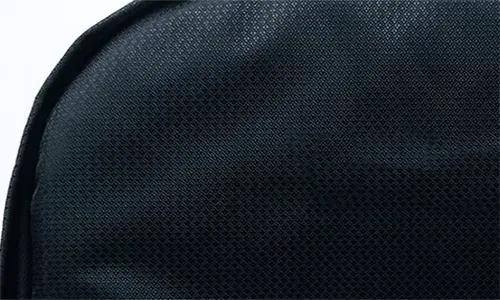
Oxford Cloth Handbag
It is wear-resistant and durable. It is not easy to be damaged even with frequent friction and slight bumps during daily commuting or outdoor activities, and has a long service life. It also has a PU coating and has good waterproof properties. When encountering light rain or accidental splashes, it can effectively block moisture from penetrating and protect the items in the bag from being dry. In addition, Oxford cloth is light in texture, making it easier and more comfortable to carry, and the fabric is easy to clean. It can be cleaned by simply wiping it after stains, taking into account both practicality and convenience.
Steps for Use

Step 1: Remove the PBM helmet from its carrying bag and insert the sponge pad or adhere the sponge strap to the inner ring of the helmet.
Step 2: Connect the helmet and adapter to the controller via the cable.
Step 3: Plug the power cord into a wall outlet.
Step 4: Press the on/off switch.
Step 5: Select the appropriate operating time, pulse frequency, and power level on the controller.
Step 6: Put on the helmet, sit in a comfortable chair, and enjoy your PBM therapy.
Applicable People

Middle-aged and Elderly People at Risk of Cognitive Decline
As people age, their brain function gradually deteriorates, leading to memory loss, difficulty concentrating, slow thinking, and even the risk of mild cognitive impairment or dementia (such as Alzheimer’s disease). This helmet can help delay cognitive decline and maintain memory and thinking skills by improving brain metabolism and promoting neuroplasticity.

Patients With Neurodegenerative Diseases
Such as Parkinson’s disease and Huntington’s disease, often experience neuronal damage and decreased motor and cognitive function during their illness. The helmet’s neuroprotective and repair mechanisms (such as promoting mitochondrial function and inhibiting inflammation) can help improve the state of neurons and alleviate cognitive symptoms (such as distractibility and decreased executive function).
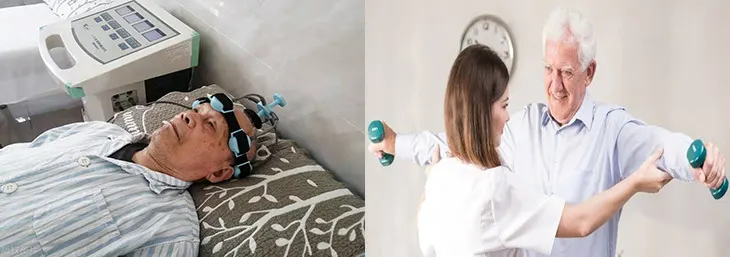
Patients Recovering From Stroke or Brain Injury
After a stroke (cerebral infarction, cerebral hemorrhage) or brain trauma, the brain may suffer from ischemia and hypoxia, leading to damage to nerve cells and symptoms such as memory impairment, difficulty concentrating, and illogical thinking. Helmets can help restore damaged nerve function and accelerate cognitive recovery by promoting neural repair and improving cerebral blood flow and metabolism.

People With Mental Health Issues
Such as depression and anxiety, often experience cognitive symptoms like inattention, slow thinking, and memory loss. The helmet can regulate neurotransmitters (such as serotonin and dopamine), improve the brain’s microenvironment, help alleviate negative emotions, and enhance cognitive function. Furthermore, patients with chronic fatigue syndrome caused by long-term stress can benefit from it by improving brain energy supply and alleviating problems like inattention and inefficient thinking.

Healthy People Who Need to Improve Their Cognitive Performance
Such as students facing high-intensity learning pressure and professionals who engage in long-term mental work may experience temporary memory loss, difficulty concentrating, and reduced thinking activity due to brain fatigue. The helmet can help improve brain state and enhance short-term cognitive performance by optimizing cerebral blood flow and enhancing nerve cell metabolism.

People with Sleep Disorders
People with chronic insomnia or poor sleep quality are prone to memory loss and difficulty concentrating due to insufficient brain rest. The helmet can help improve sleep-related cognitive problems by regulating nerve function and improving blood circulation in the brain, indirectly enhancing the brain’s focus and information processing abilities.
Applicable Places

Hospital

Community Health Center

Nursing Home

Rehabilitation Center
Product Testing
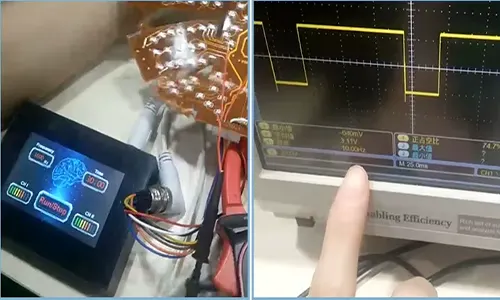
Frequency Testing
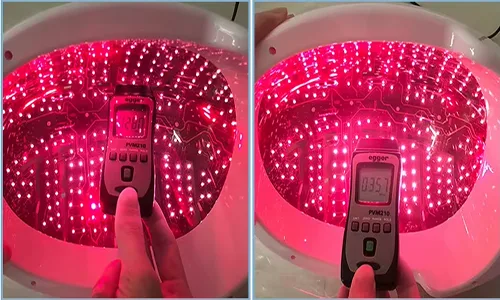
Optical Power Testing
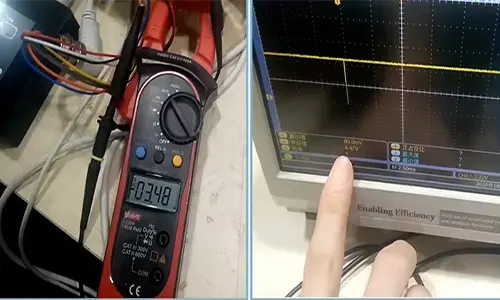
Current/Voltage Testing
Customization Options
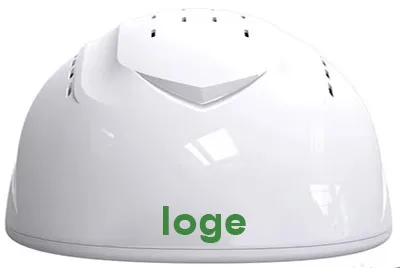
LOGO Customization
Make your brand unique, starting with its symbol. A good logo is more than just a graphic; it’s the face of your brand—embodying your philosophy, your spirit, and even your story, instantly capturing your heart. Customization is about precisely fitting this face to your brand, rejecting cookie-cutter templates and creating a unique expression.
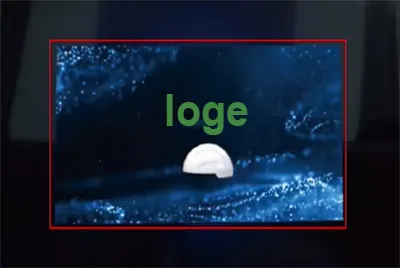
Controller User Interface Customization
Make the operation perfectly “in tune” with your needs. The controller is the “bridge” for interaction between people and equipment, and an interface that meets the needs can make the operation go from “making do” to “smooth”, and even improve efficiency and reduce errors.
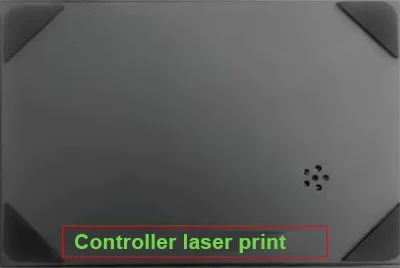
Controller Laser Print Customization
Let the details imprint their own unique identity, making them durable and recognizable. As the core hub of device operation, the controller is not only functional but also meticulously crafted to convey professionalism and uniqueness. Custom laser printing utilizes high-precision, durable technology to allow your controller to be “tailored” with logos, branding, and function prompts, meeting practical needs while showcasing a unique and distinctive character.
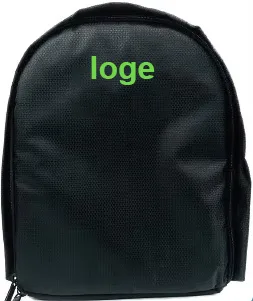
Cloth Bag Rubber Logo Customization
A backpack isn’t just a way to carry your products; it’s your brand’s “mobile calling card.” From craftsmanship to presentation, the choice is yours. We offer a variety of custom crafts tailored to your style preferences, ensuring both aesthetics and durability.
FAQ
Numerous scientific studies have shown that 810nm near-infrared light can penetrate the scalp and skull, be absorbed by brain tissue, and thereby promote cellular metabolism, increase mitochondrial activity, and enhance the production of ATP (adenosine triphosphate, the cellular energy currency), thereby improving blood circulation and neural function in the brain. Our helmet is based on these scientific findings and has undergone extensive research, testing, and optimization by a professional team. Clinical trials have also shown positive effects in improving sleep quality, relieving stress, and enhancing concentration.
The results vary from person to person and are related to frequency of use and individual physical condition. Some users report that consistent daily use for 10-20 minutes can improve focus and reduce fatigue after 2-4 weeks. For issues like anxiety and mild depression, consistent use for 1-3 months may be necessary, along with a healthy lifestyle to improve mood. The specific effects depend on individual circumstances, and it is recommended as an adjunct measure, not a substitute for professional treatment.
This helmet underwent rigorous safety testing during its development process. Light with a wavelength of 810nm is near-infrared, which, at appropriate energy levels, is relatively safe for the human body and does not damage skin or tissue like ultraviolet light. Furthermore, our product design incorporates multiple safety protection mechanisms. For example, if abnormal overheating or unstable light intensity is detected, the device will automatically shut down to ensure your safety. We have also obtained relevant safety certifications and comply with industry standards and regulatory requirements.
Theoretically, photobiomodulation therapy can be used concurrently with some non-invasive brain health products (such as head massagers), but it is recommended to maintain a certain interval between them to avoid overstimulation of the head. If using this therapy concurrently with other treatments (such as medication or physical therapy), especially for specific brain disorders, consult a doctor or professional beforehand, as different treatments may interact, ensuring safety and effectiveness.
810nm near-infrared light is invisible, and its wavelength and energy setting do not directly stimulate the retina, so it is not harmful to the eyes during normal use. However, for greater peace of mind, we recommend relaxing naturally during use without intentionally closing your eyes. However, we also recommend not looking directly at the light source (although the light source itself is shielded from the eyes by the helmet structure). Therefore, there is no need to wear goggles. The helmet’s optical path design ensures that the light primarily affects the brain area, preventing leakage and direct exposure to the eyes, so you can use it with confidence.
Reviews (0)
Be the first to review “810nm Brain Photobiomodulation Helmet” Cancel reply
You must be logged in to post a review.

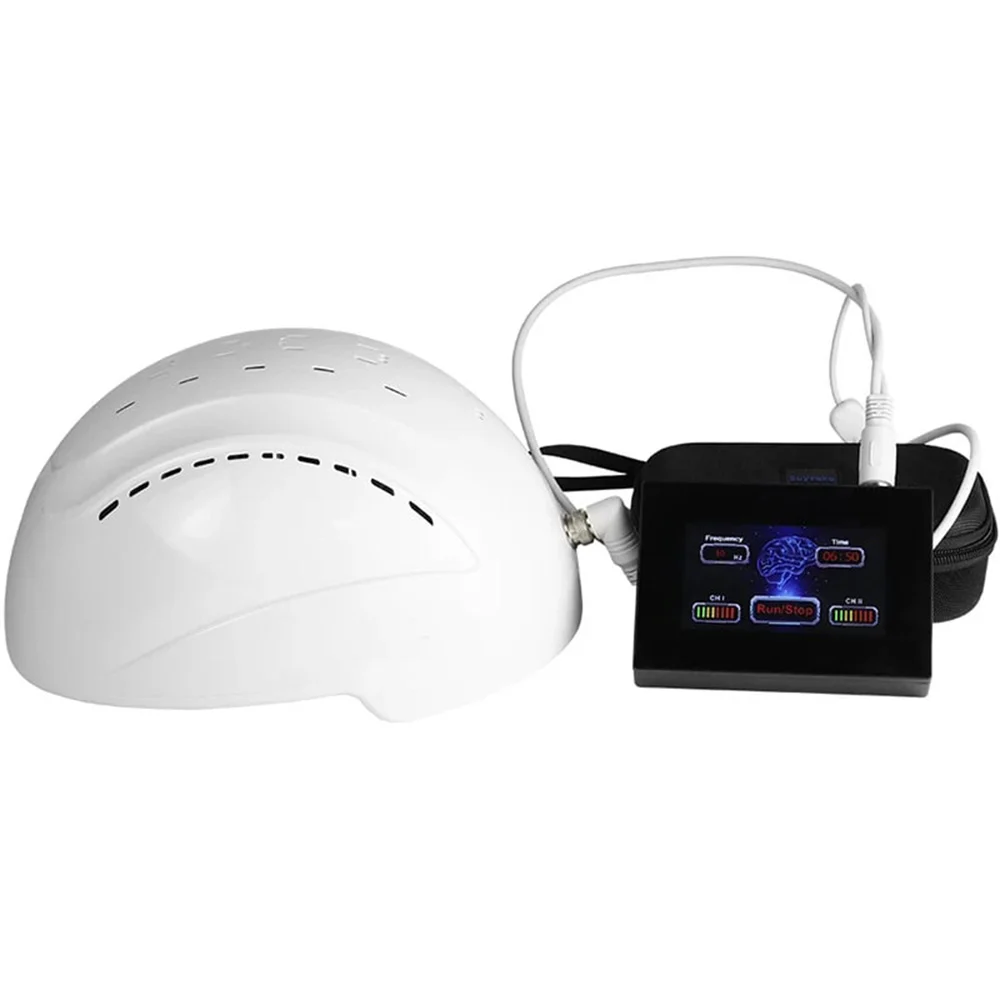
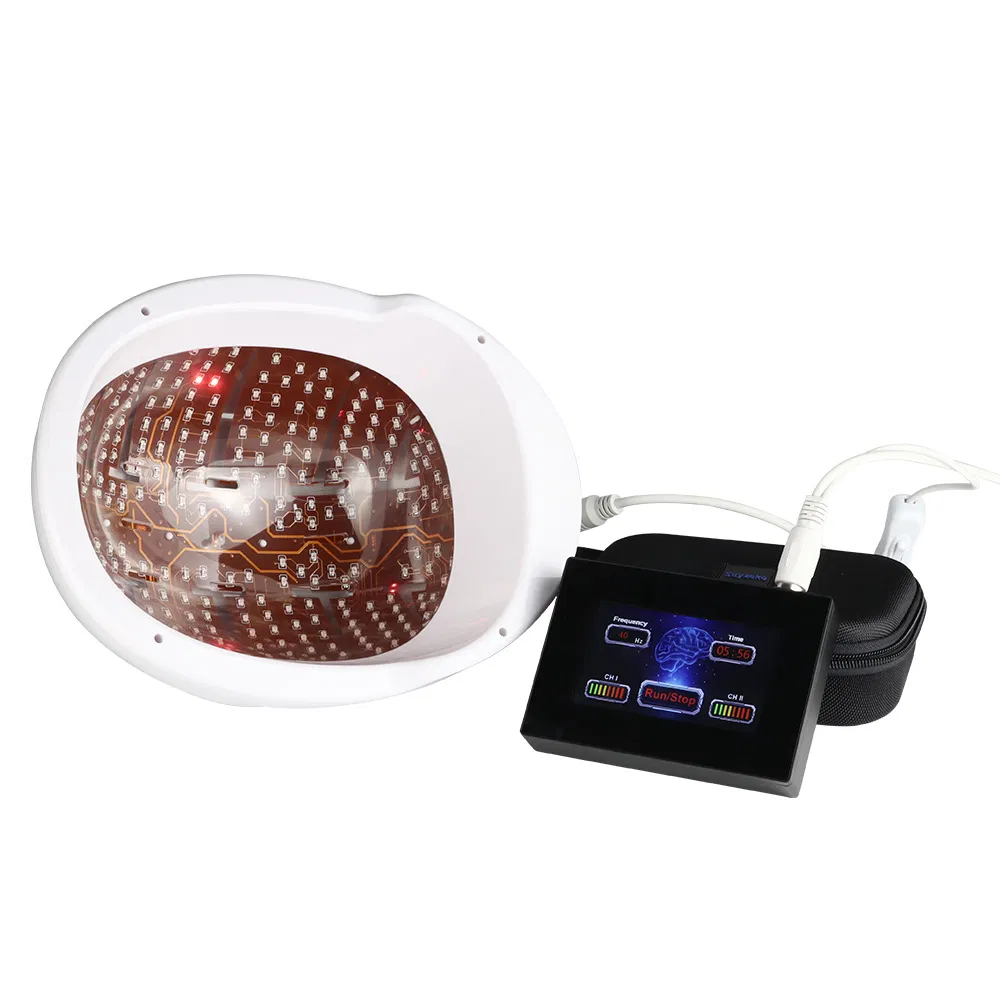
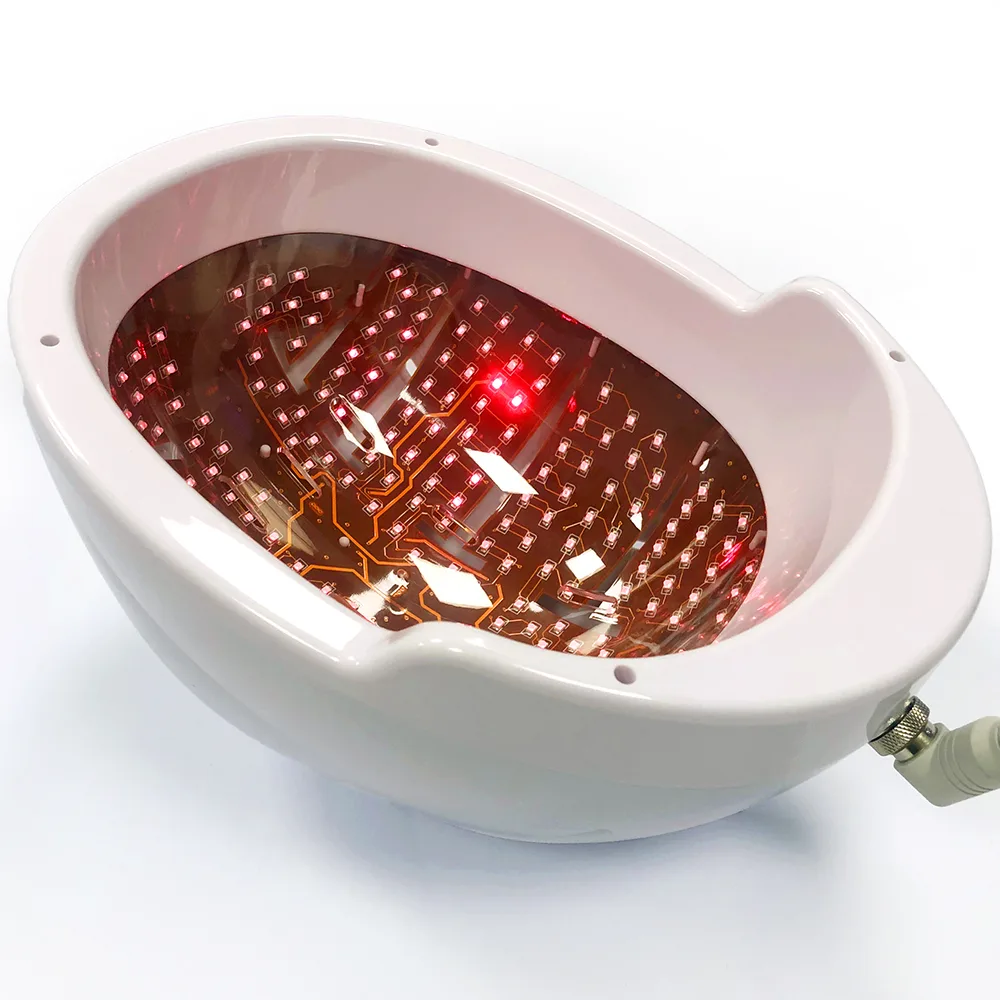
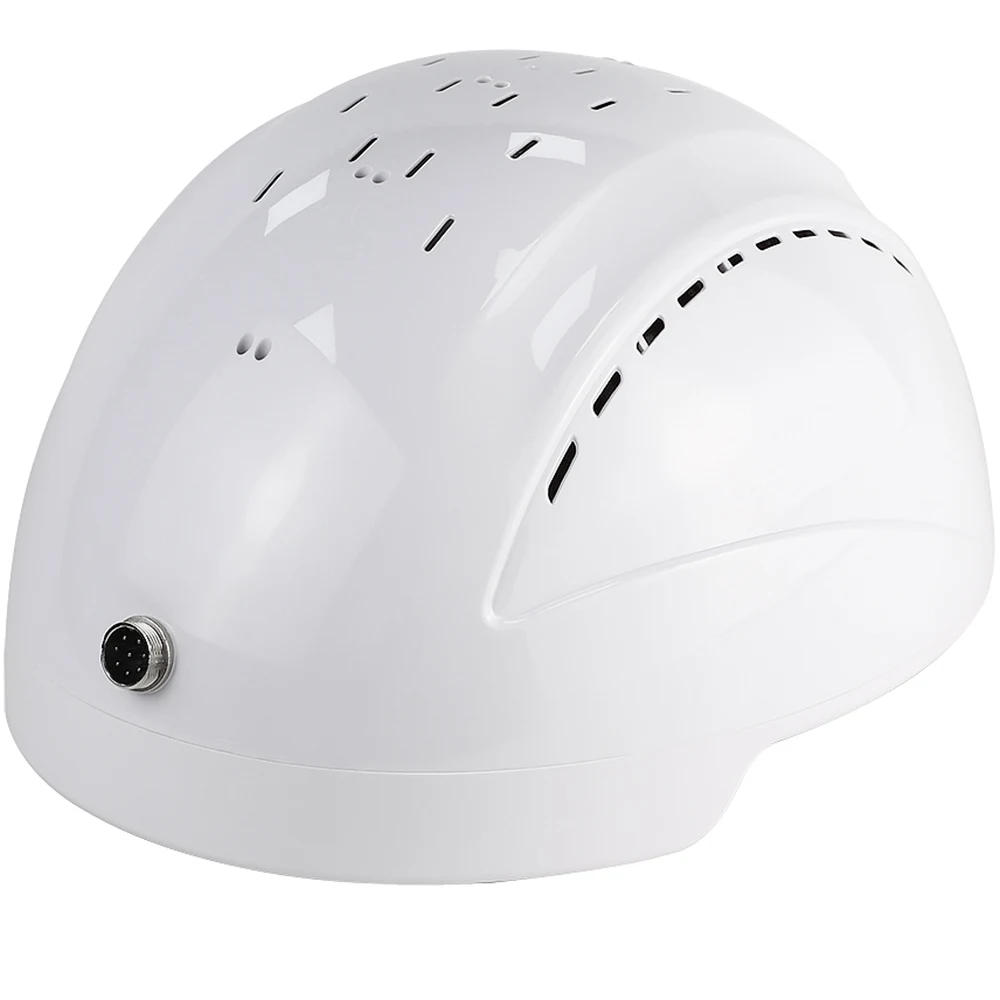
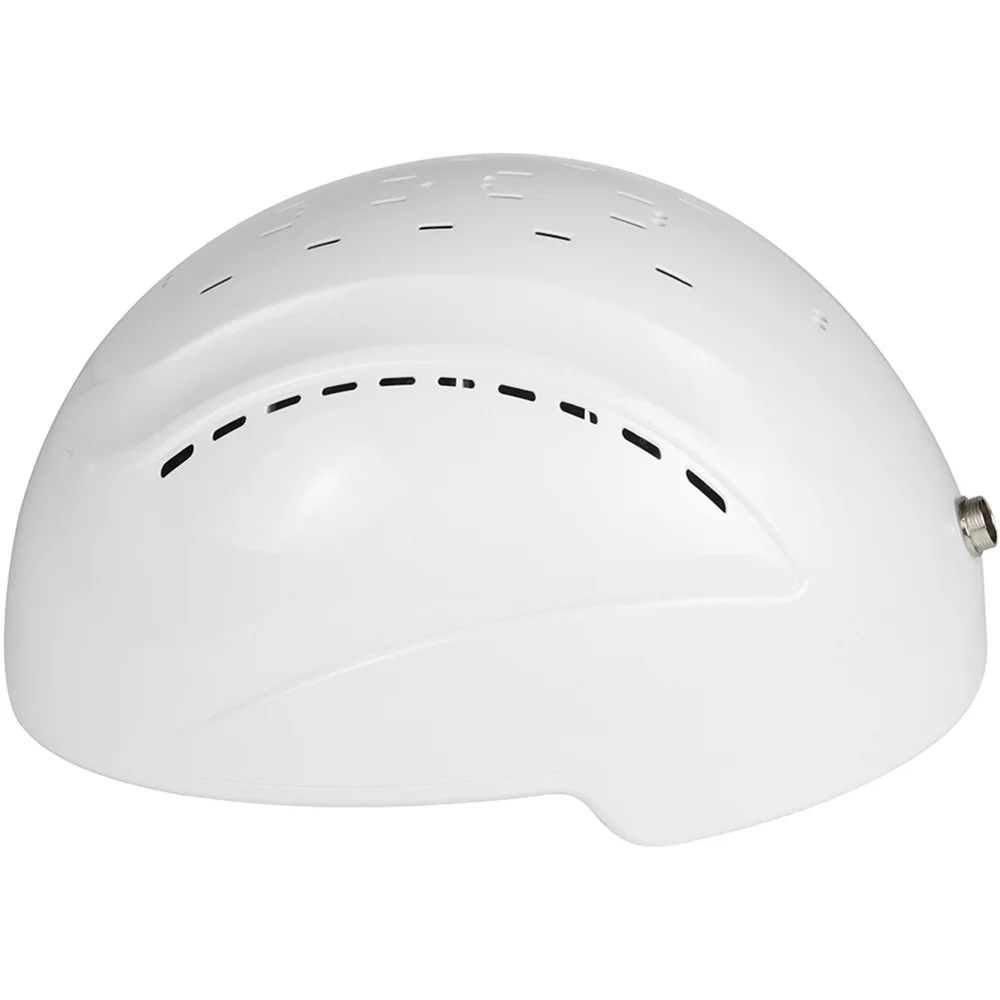
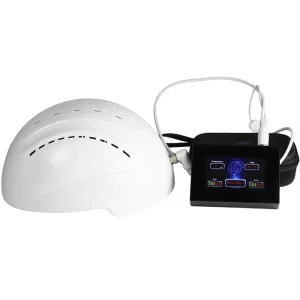
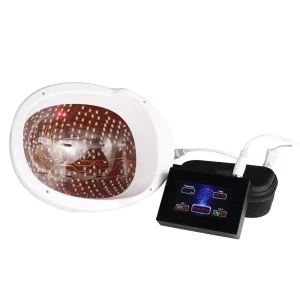
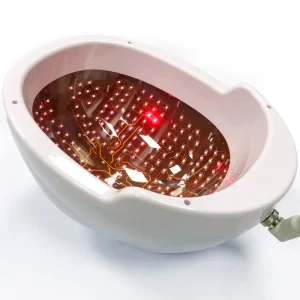
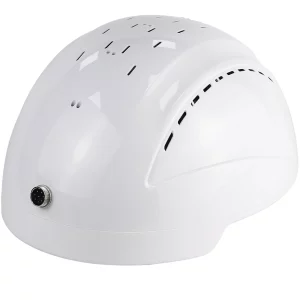
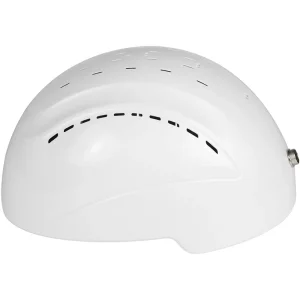
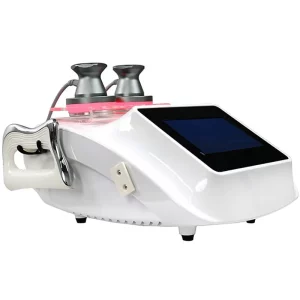
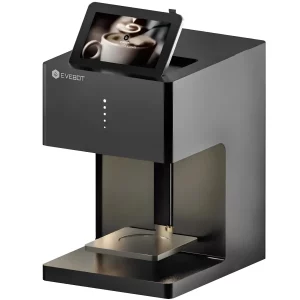
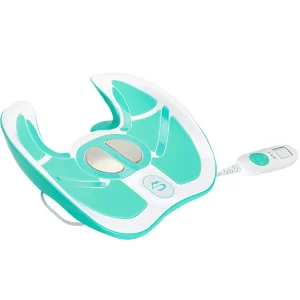
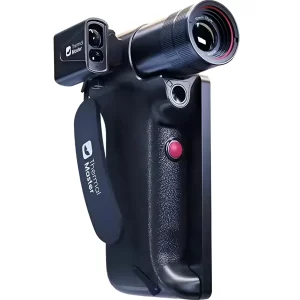
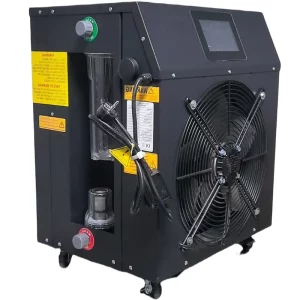
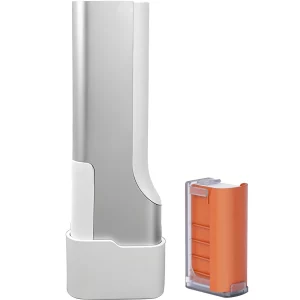
Reviews
There are no reviews yet.